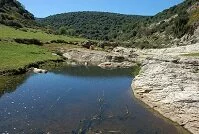Weather

River in Rosh Pinna
Israel falls in between deserts, tropics, and the Mediterranean Sea so they get aspects of all of these climates. Additionally, due to the incredible geographic diversity, the weather can be substantially different from one location to the next as the Mediterranean may warm the coast, the inland mountains near Jerusalem may experience rain or snow, and the lands around the Dead Sea remain a hot, arid desert.
For much of the year, most of the country experiences weather that is hot and dry; the summers in Israel last from about April to October. Despite the summer season throughout the country, due to geographic variations, temperatures and humidity during the summer can vary drastically across the country. Along the Mediterranean humidity is relatively high, while inland it is quite dry. Temperatures also vary as along the coast temperatures tend to have daily highs of about 95° F (35° C), but nights dip to only 45 to 50° F (7 to 10° C) while in Jerusalem temperatures almost always stay between 65 and 85° F (18 and 30° C). During the winters, from November to March, the country gets more rain and cooler temperatures with ranges between about 40 and 65° F (4 to 18° C) along the coast in Tel Aviv and between 30 and 50° F (-1 to 10° C) in Jerusalem.
Wildlife

Beach in Ashkelon
There are few large mammals in Israel today and the numbers are severely limited; these animals include the gazelle, boar, fox, and ibex among others. There are over 100 mammal species in the country, but the number of each is small and sightings are rare outside the more common hare or rodent. There is also significant sea life in the surrounding waters, although most inland rivers and lakes (such as the Dead Sea) are all but void of animal life. The Mediterranean however boasts a large number of fish and shellfish along with coral and other sea life. Here there are thousands of fish species along with dolphins, turtles, and more.
There are a significant number of birds in Israel as well; most of these only migrate through on the Africa-Middle East-Europe migratory route. Among the more common of these are pelicans, buzzards, warblers, ducks, eagles, falcons, and hawks. The reptilian and amphibian life is more limited, particularly the amphibian life.